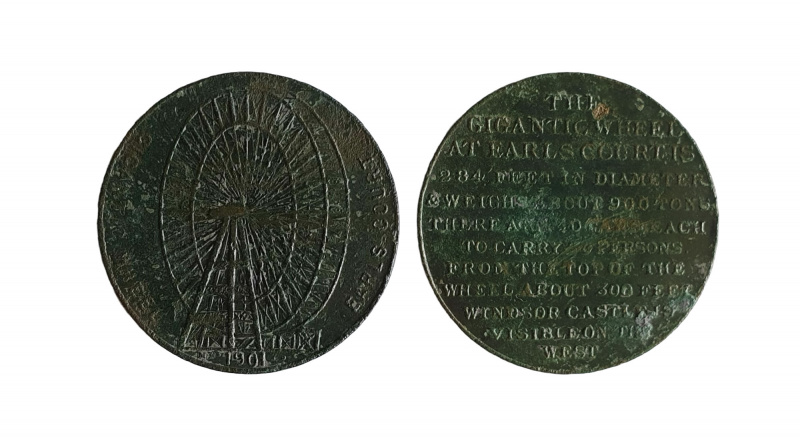Earls Court Great Wheel Medal
Rather than being a coin or a token, this item was made to commemorate something. It is another find from the collection built up by Stephen Palmer.
It measures about 35mm in diameter, it’s made of bronze and dates from the last decade of the 19th century. On one side is an image of a ‘big wheel’ with a date below; to the left is GIGANTIC WHEEL and to the right is EARLS COURT. The London Eye has for a number of years been a major attraction both for Londoners and tourists from all over the world. The Eye is a fixture but smaller wheels travel around the UK. They are erected in various cities and usually stay for a few months before being taken down and moving on. When they are positioned in the centre of a city they tower over rooftops, enabling those at the highest point to see places and landmarks they had never viewed before.
Earls Court Wheel

The Great Wheel in Earl’s Court Exhibition Ground, c. 1900.
On the other side are more details of the Earls Court wheel. It was 284 feet in diameter, the supporting structure stood 308 feet tall, it weighed about 900 tons and had 40 cars capable of carrying 30 people in each one. When it was made welding wasn’t used on large metal structures, so all the steelwork would be riveted together. This would be a very onerous task for those involved, as tens of thousands of holes would need to be drilled and then filled with rivets heated up to make them soft. It would also be very noisy, when the rivets were hit several times with heavy hammers in order to secure them in the drilled holes. The wheel at Earls Court operated from 1895 to 1906 and during this period no less than 2,500,000 passengers enjoyed a ride on it.
Ferris Wheel
The first attraction of this type was the Chicago Ferris Wheel, which proved to be so popular that it was speedily copied by others. The one at Earls Court was made by Maudslay, Sons and Field, an engineering company managed by Walter B. Basset; a young engineer, H. Cecil Booth, was responsible for much of the original design. Opening in 1895 (for the India Empire Exhibition), wheels similar to Earls Court were erected in Vienna in 1897 and in Paris in 1899.
Heavy engineering
At the start of the 19th century heavy engineering was still in its infancy. By 1900 railways cross-crossed the UK, enormous steel ships traveled the world over and machines had been invented to make all manner of things. Great Britain had become the workshop of the world and exported its products to every corner of the globe. However, when other countries gained the skill and know-how to create their own industries they had less need for British products. Sadly (for us) the development and expansion of industries overseas has in many cases led to a decline in our own.
Valuation
This commemorative medal/advertising piece has a few slight surface defects but is otherwise in very good condition. Examples aren’t particularly scarce, so I’d give this one a price range no higher than £20 – £30.
Coin Valuation Service
Have your coin or artefact valued using my free online coin valuation service

